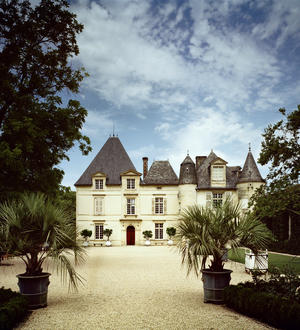2022 Le Clarence de Haut-Brion, Pessac-Léognan, Bordeaux
- Red
- Dry
- Full Bodied
- Merlot (62.1%),Cabernet Sauvignon (21.9%),Cabernet Franc (14.5%),Petit Verdot (1.5%)
For laying down
Product: 20228014317
75 cl Bottle
37.5 cl Half Bottle
150 cl Magnum
300 cl Double Magnum
600 cl Imperial
900 cl Salmanazar
Description
This wine has a very appealing initial bounce of fruit. It has a well-managed drive of red fruit across the palate, quite rounded and ripe but with a bit of zip and lift. The tannins are present but not intrusive. There is a distinctive gentle mocha note as the wine approaches the finish.
This is not hugely complex, but there is much to enjoy. Many of Haut-Brion’s grand vin notes can be detected, but more in reflection than intensity.
Merlot 61%; Cabernet Sauvignon 22%; Cabernet Franc 14%; Petit Verdot 2%
Drink 2027 - 2040
Score: 16.5/20
Berry Bros. & Rudd (April 2023)
Colour Red
Sweetness Dry
Vintage 2022
Maturity For laying down
Grape List Merlot (62.1%),Cabernet Sauvignon (21.9%),Cabernet Franc (14.5%),Petit Verdot (1.5%)
Body Full Bodied
Producer Château Haut-Brion
About this wine

Merlot
The most widely planted grape in Bordeaux and a grape that has been on a relentless expansion drive throughout the world in the last decade. Merlot is adaptable to most soils and is relatively simple to cultivate. It is a vigorous naturally high yielding grape that requires savage pruning - over-cropped Merlot-based wines are dilute and bland. It is also vital to pick at optimum ripeness as Merlot can quickly lose its varietal characteristics if harvested overripe.
Find out more

Chateau Haut-Brion
The only property from outside the Médoc to be included in the 1855 Classification, Haut-Brion’s viticultural history can be traced back further than its Médoc First Growth counterparts. Samuel Pepys even mentions it in his diaries. Situated in what is now Pessac-Léognan, the property finds itself now in the suburbs of the ever-encroaching city of Bordeaux. After falling into a state of disrepair the estate was purchased in 1935 by Clarence Dillon, an American financier, since when it has enjoyed a steady and continual resurgence to a position of pre-eminence. Dillon’s great-grandson, Prince Robert of Luxembourg, now runs the estate, but a key influence in the reputation which Haut-Brion enjoys today is the Delmas family. George Delmas was manager and wine-maker until 1960, when his son Jean-Bernard took over. Jean- Bernard was a visionary figure, responsible for a number of important innovations, and on his retirement in 2003 his son Jean-Philippe took over as Directeur Générale. The vineyard is planted to 40% Cabernet Sauvignon, 37% Merlot and 18% Cabernet Franc. A stunning white wine is also made, from a part of the vineyard which is 63% Semillon and 37% Sauvignon Blanc. Production is smaller than at the other First Growth Wines, totalling about 20,000 cases, shared between the Grand Vin and a second wine, formerly called Bahans-Haut-Brion but changed in 2007 to Clarence de Haut-Brion in recognition of Clarence Dillon. Production of Haut Brion Blanc is minute, less than 800 cases in most years. Beginning with the 2009 vintage a new white wine was introduced in the place of Clarence: La Clarté de Haut-Brion, the offspring of Domaine Clarence Dillon's two prestigious white wines: Château Haut-Brion Blanc and Château La Mission Haut-Brion Blanc. Fermentation of the red wines takes place in stainless steel vats, after which the wine will spend 22 months, sometimes more, in new oak barrels before being bottled unfiltered. For the white wine fermentation takes place in new oak barrels, after which the wine spends a further year to 15 months on its lees in barrel before bottling. The white wine is truly sensational, equivalent in class to a top-flight White Burgundy Grand Cru, but its scarcity means that it is rarely seen. The red wine is no less extraordinary; at its best it displays text-book Graves characteristics of cigar-box, curranty fruit, earth, smoky spice and cassis. The high Merlot content, compared to the Médoc First Growths, gives it a voluptuous edge, but does not in any way detract from its ability to age.
Find out more
